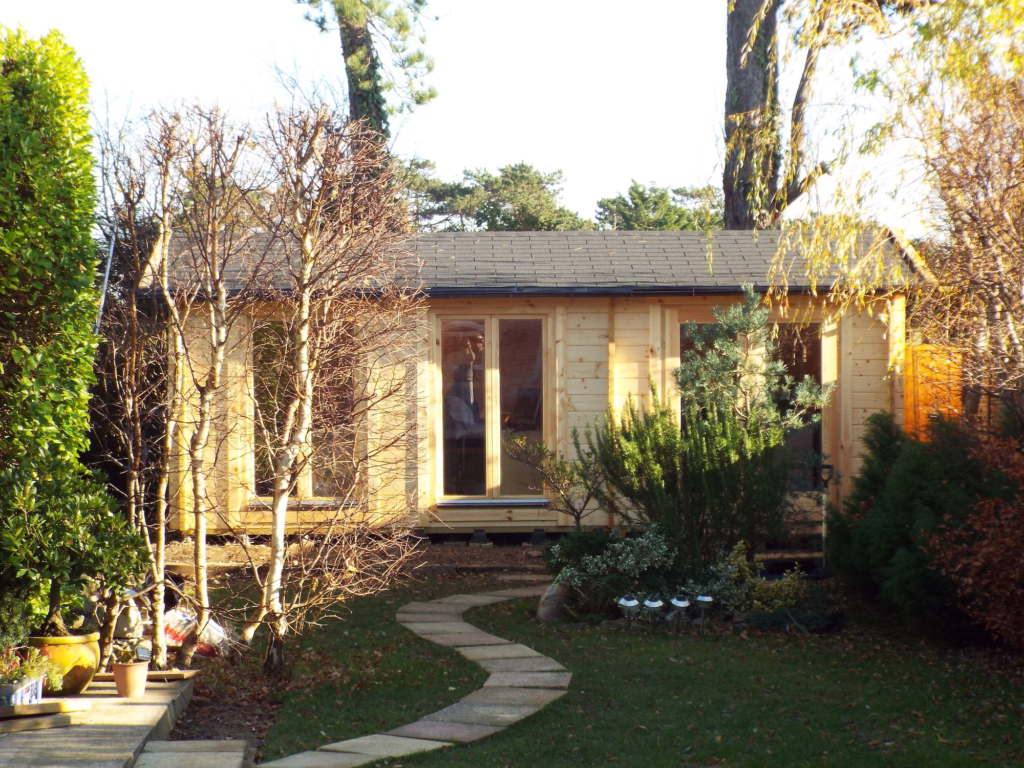
When you live in a climate like ours and have to suffer incessant rain – even at the height of what is supposed to be our summer! – it’s certainly advisable to do what you can to keep your cabin as dry as possible to prevent the logs from rotting.
Water splashing up from the ground onto the logs at the bottom of a cabin is the number one cause of wood decay and rot.
So, what can you do to help keep your cabin dry?
1. Treat the Exterior Logs of Your Cabin with a Good Wood Preservative
Make sure the treatment:
* is water resistant and keeps the water and condensation from the exterior surface out
* allows the logs to breathe, ensuring the moisture inside to make its way out
It’s important to treat the cabin as soon as possible after it has been installed, preferably in the first week and certainly within 4-6 weeks, repeating this every couple of years.
**Recommendation** – Cuprinol Wood Preserver
- Treat with wood preservative
- Follow this with 2-3 coats of good quality stain or paint
- Cover the timbers thoroughly – this includes the edges and sides of the eaves and fascia boards
- Ensure every surface of the doors and windows are painted to stop warping and swelling
It is also advisable to treat the roof boards and floor before installing the cabin to:
* protect the underside of the floorboards from damp getting into the log
* protect the roof boards from air moisture penetrating them which can result in swelling and sometimes lifting where humidity is high (your choice of roof covering, ie. felt, shingles or EPDM, will protect the roof from the rain but not the roof boards)
It’s important also to treat the interior walls of the cabin as moisture can build up inside.
See my blog How to Treat a Log Cabin for further advice.
2. Guttering
* Minimises backsplash and water exposure on the cabin walls from rain falling from the roof
* Helps keep the water away from the foundations, walls, doors and windows
* Helps protect the treatment of the cabin by stopping the wall logs from deteriorating considerably faster from sustained contact with rainwater
It’s a good idea not to install the cabin under trees to prevent leaves and other debris falling on to the roof and blocking the guttering.
However, if this is not possible, you can fit a mesh cover on top of the gutters to help keep the debris out but allowing the rainwater to filter through.
See my blog How to Install Guttering on a Log Cabin for advice.
3. Clear soil and other debris from around the bottom of the cabin
It’s important that debris, soil and mulch, all prime areas for water to collect, are at least 3 feet from the bottom of the cabin to help prevent mould from the moisture develop in the logs.
Ensure the soil slopes down from the cabin to encourage sufficient drainage away from the foundations.
4. Make sure the base is the same size as the footprint of the cabin
If the base is larger than the footprint, any water running off the cabin will gather and increase the risk of water seeping into the logs.
5. Large Roof Overhangs
Choosing a cabin with large roof overhangs:
* Is a good way of reducing rainwater falling onto, and getting into, the logs
* Helps control water falling close to the base of the cabin and prevent backsplash
6. Pay attention to logs underneath windows
There is a tendency for water to collect on logs directly under windows which can lead to rot.
It is therefore vital to ensure the seal between the bottom of the window and the top of the log is tight.
7. Raise the cabin above the surrounding ground
If possible, the cabin should be constructed at the highest point in the garden.
If this is not possible, it is recommended the cabin is raised at least two inches off the ground to help prevent:
* Rainwater falling from the roof splashing back onto the lower logs
* Any garden plants and shrubs, tree roots and moisture from the soil causing damage to the logs
